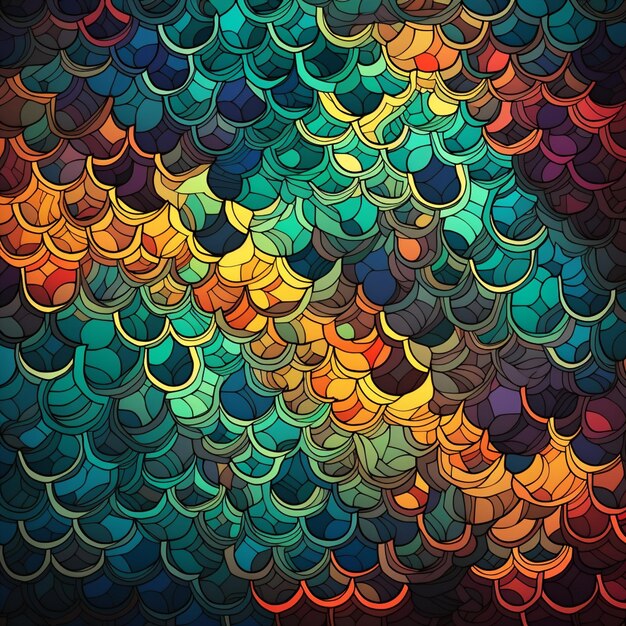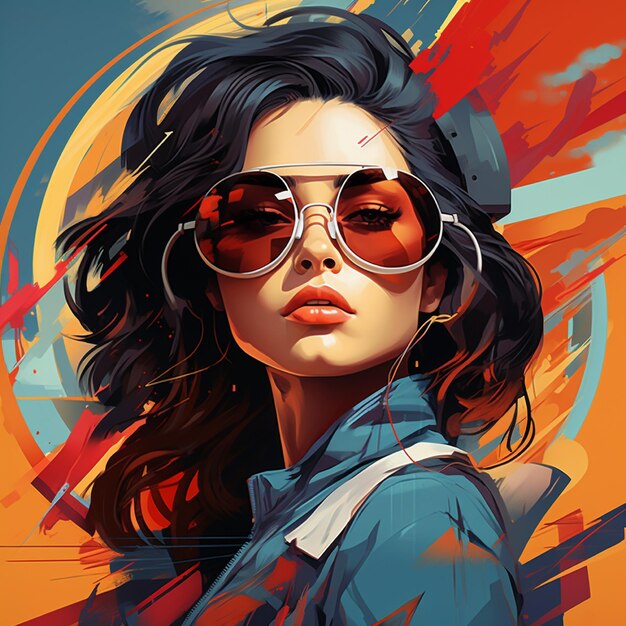Vector art is a captivating form of digital illustration that uses mathematical equations to create images. Unlike raster graphics, which are made of pixels, vector images maintain their quality regardless of size. This makes them essential for various applications, from logos to billboards. The importance of vector art cannot be overstated; it allows for scalability, versatility, and precision in design. Whether you’re a business needing a logo that looks sharp on any platform or an artist exploring creative avenues, understanding vector art opens up a world of possibilities.
The Creative Process of Designing Vectors

Creating stunning vector art is both an art and a science, requiring a blend of creativity and technical skill. Here’s a peek into the creative process that artists typically follow when designing vectors for platforms like VectorStock:
- Research and Inspiration: Every great design starts with inspiration. Artists often explore various sources, such as nature, architecture, or existing designs. Websites like Pinterest and Behance can be treasure troves of ideas.
- Sketching Ideas: Once the research phase is complete, artists usually sketch their ideas on paper or digitally. This brainstorming stage is crucial for visualizing concepts and refining thoughts before moving to software.
- Choosing the Right Software: Popular software like Adobe Illustrator or CorelDRAW is commonly used for vector creation. These programs offer tools that help in crafting precise shapes and lines, essential for clean designs.
- Creating Shapes and Lines: The magic begins when artists start creating shapes. By combining basic geometric shapes—like circles, rectangles, and polygons—they build complex designs. Adjusting the paths and curves allows for fluidity and uniqueness.
- Adding Color and Texture: Color brings vector art to life! Artists choose color palettes that evoke certain emotions or fit the brand’s identity. Gradients and textures can also be applied to add depth and interest.
- Refinement: This phase is all about polishing the design. Artists zoom in to tweak details, ensuring every line is perfect, every color is balanced, and the overall composition is harmonious.
- Final Review and Export: Before submitting their work, artists conduct a final review. They'll check for any inconsistencies or errors. Once satisfied, they export the vector in various formats (like .AI, .EPS, or .SVG) suitable for different uses.
Creating stunning vectors is a rewarding journey. It combines artistic vision with technical prowess, resulting in designs that can captivate audiences and serve multiple purposes. Whether for branding or personal projects, the creative process remains the same: thorough research, imaginative sketching, and meticulous execution.
Also Read This: How to Spark Your Creativity Using Stunning Graphics from VectorStock
3. Step-by-Step Guide to Creating Stunning Vectors

Creating stunning vectors is an exciting process that combines creativity and technical skills. Let’s break it down into manageable steps to help you navigate your journey into the world of vector design.
Step 1: Brainstorm Your Concept
Before you jump into the software, take a moment to brainstorm. What do you want to convey with your vector? Sketch out your ideas on paper. This doesn’t need to be perfect; it’s about capturing the essence of your thoughts.
Step 2: Choose Your Software
There are several excellent tools for vector design, including:
- Adobe Illustrator
- CorelDRAW
- Inkscape (free and open-source)
Choose one that suits your needs and budget. If you're a beginner, Inkscape is a great starting point!
Step 3: Set Up Your Document
Open your software and create a new document. Set the artboard size based on where you intend to use your vector—whether it’s for web graphics, printing, or something else. Remember, vectors are scalable, so you can adjust the size later without losing quality!
Step 4: Create Basic Shapes
Start with basic shapes. Use rectangles, circles, and polygons as building blocks for your design. Don’t be afraid to overlap shapes—this is where the magic happens!
Step 5: Refine Your Design
Once you have the basic layout, refine your design. Adjust the curves, angles, and edges. Use the pen tool for custom shapes. This is your chance to make your vectors unique!
Step 6: Add Details
Details matter! Add intricate elements like lines, patterns, or textures. This step is crucial for adding depth and interest to your work.
Step 7: Experiment with Colors
Color can transform your vector. Play with different color palettes. Use gradient fills to add dimension. Remember, you can always revert back if you don't like a choice!
Step 8: Final Touches
Take a step back and evaluate your design. This is the time to make any last-minute tweaks—adjusting colors, refining shapes, or adding shadows. Make sure everything is aligned and polished.
Step 9: Save and Export
Finally, save your work in the native file format of the software you’re using. When you’re ready to share or sell your vector, export it in formats like SVG, EPS, or PDF, ensuring the highest quality for your audience!
Also Read This: Fun Facts About VectorStock You Probably Didn’t Know Before
4. Color Theory and Its Role in Vector Design
Color theory is a fundamental aspect of design that can make or break a vector illustration. Understanding how colors interact can elevate your work, making it more appealing and effective.
Understanding the Color Wheel
The color wheel is a visual representation of colors arranged according to their chromatic relationship. Here are some key components:
- Primary Colors: Red, blue, and yellow. These colors cannot be created by mixing other colors.
- Secondary Colors: Green, orange, and purple. These are made by mixing primary colors.
- Tertiary Colors: The result of mixing a primary color with a secondary color, like red-orange.
Color Harmony
Color harmony refers to pleasing combinations of colors. Here are a few popular schemes:
- Complementary: Colors opposite each other on the wheel. For example, blue and orange.
- Analogous: Colors next to each other, like blue, teal, and green.
- Triadic: Three colors evenly spaced around the wheel, such as red, yellow, and blue.
Psychology of Colors
Colors evoke emotions and can influence perceptions. For example:
- Red: Passion, energy, urgency.
- Blue: Trust, calmness, professionalism.
- Green: Growth, tranquility, health.
When designing vectors, think about the message you want to convey and choose your colors accordingly!
Using Color in Vectors
In vector design, color choices affect overall composition and audience engagement. Here are a few tips:
- Use a limited color palette to create coherence.
- Incorporate gradients for depth and interest.
- Test colors in different contexts to see how they interact.
By mastering color theory, you can create vectors that not only look amazing but also communicate effectively with your audience!
Also Read This: Summer Design Inspiration Made Easy with VectorStock Graphics
5. Best Practices for Uploading Vectors to VectorStock
If you're an aspiring vector artist looking to make a mark on VectorStock, it's essential to follow some best practices for uploading your artwork. These tips will help ensure your vectors are not only high-quality but also more likely to get approved and sell well. Here’s what you need to keep in mind:
- Quality is Key: Always aim for high-resolution files. A good rule of thumb is to create vectors at a minimum of 300 DPI. Crisp and clear graphics are more appealing to buyers.
- Follow the Guidelines: VectorStock has specific submission guidelines, including acceptable file formats (like AI, EPS, or SVG). Make sure to adhere to these to avoid rejection.
- Use Descriptive Keywords: When uploading your vector, think about the keywords that potential buyers might use to search for your art. Include relevant terms that describe the content, style, and purpose of your artwork.
- Optimize Your Artwork: Before uploading, clean up your vector files. Remove any unnecessary layers, hidden objects, or unused swatches. This not only reduces file size but also helps in maintaining a clean design.
- Preview Your Upload: Take advantage of the preview feature to see how your artwork will appear on the site. This step allows you to catch any mistakes or areas for improvement.
By following these best practices, you can increase the chances of your vectors being accepted and selling successfully on VectorStock. Quality, detail, and attention to user needs are what will set your vectors apart in a competitive marketplace.
6. Conclusion: The Future of Vector Art
The future of vector art is looking incredibly bright. As technology continues to advance, the tools and platforms available for artists are evolving, making it easier than ever to create and share stunning artwork. Here are a few trends and insights that indicate where vector art is headed:
- Integration with AI: We are seeing a significant rise in AI-assisted design tools. These tools can help artists enhance their creativity by suggesting color palettes or generating unique patterns.
- Increased Demand: As businesses shift more to digital platforms, the demand for high-quality vectors is skyrocketing. Companies are looking for distinct graphics to stand out in a crowded online space.
- Community Collaboration: Platforms like VectorStock foster a sense of community among artists. This collaboration leads to sharing techniques, styles, and even direct partnerships for projects.
- Sustainability and Ethical Art: Artists are becoming more conscious of the materials and practices they use. Vector art offers a sustainable choice for businesses looking to minimize their environmental impact.
In conclusion, as we look ahead, it's clear that vector art will continue to play a vital role in the digital landscape. By honing your skills and adapting to these trends, you can position yourself at the forefront of this dynamic field. VectorStock and similar platforms will remain key players in connecting artists with the audiences that crave unique, high-quality vector designs.
 admin
admin








